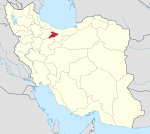Sehatabad Rural District
Appearance
Sehatabad Rural District
Persian: دهستان صحتاباد | |
|---|---|
| Coordinates: 35°45′27″N 50°20′42″E / 35.75750°N 50.34500°E[1] | |
| Country | Iran |
| Province | Alborz |
| County | Eshtehard |
| District | Central |
| Capital | Sehatabad |
| Population (2016)[2] | |
• Total | 3,403 |
| Time zone | UTC+3:30 (IRST) |
Sehatabad Rural District (Persian: دهستان صحتاباد) is in the Central District of Eshtehard County, Alborz province, Iran. Its capital is the village of Sehatabad.[3]
History
[edit]In 2010, Karaj County was separated from Tehran province in the establishment of Alborz province.[4]
In 2012, Eshtehard District was separated from the county in establishing Eshtehard County, and Sehatabad Rural District was created in the new Central District.[3]
Demographics
[edit]Population
[edit]At the time of the 2016 National Census, the rural district's population was 3,403 in 1,035 households. The most populous of its 42 villages was Eshtehard Industrial Town (شهرک صنعتي اشتهارد), with 1,217 people.[2]
See also
[edit]References
[edit]- ^ OpenStreetMap contributors (16 August 2024). "Sehatabad Rural District (Eshtehard County)" (Map). openstreetmap.org (OpenStreetMap) (in Persian). Retrieved 16 August 2024.
- ^ a b Census of the Islamic Republic of Iran, 1395 (2016): Alborz Province. amar.org.ir (Report) (in Persian). The Statistical Center of Iran. Archived from the original (Excel) on 28 January 2020. Retrieved 19 December 2022.
- ^ a b Rahimi, Mohammad Reza (2012) [Approved 17 March 1391]. Approval letter regarding national divisions in Alborz province. rc.majlis.ir (Report) (in Persian). Ministry of the Interior, Board of Ministers. Notification 50868/T46965H. Archived from the original on 5 February 2013. Retrieved 21 August 2024 – via The Research Center of the Islamic Council of Iran.
- ^ Larijani, Ali (2010) [Approved 16 April 1389]. Alborz province establishment law. lamtakam.com (Report) (in Persian). Guardian Council. Notification 412/30588. Archived from the original on 16 December 2023. Retrieved 21 August 2024 – via Lam ta Kam.


